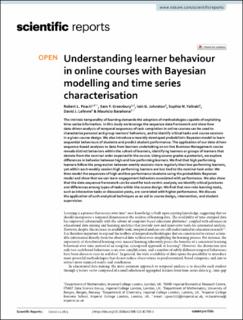| dc.contributor.author | Johnston, Iain George | |
| dc.contributor.author | Greenbury, Sam | |
| dc.contributor.author | Peach, Robert | |
| dc.contributor.author | yaliraki, sophia | |
| dc.contributor.author | Lefèvre, David | |
| dc.contributor.author | Barahona, Mauricio | |
| dc.date.accessioned | 2021-08-06T09:39:54Z | |
| dc.date.available | 2021-08-06T09:39:54Z | |
| dc.date.created | 2021-03-16T09:16:04Z | |
| dc.date.issued | 2021 | |
| dc.identifier.issn | 2045-2322 | |
| dc.identifier.uri | https://hdl.handle.net/11250/2766763 | |
| dc.description.abstract | The intrinsic temporality of learning demands the adoption of methodologies capable of exploiting time-series information. In this study we leverage the sequence data framework and show how data-driven analysis of temporal sequences of task completion in online courses can be used to characterise personal and group learners’ behaviors, and to identify critical tasks and course sessions in a given course design. We also introduce a recently developed probabilistic Bayesian model to learn sequential behaviours of students and predict student performance. The application of our data-driven sequence-based analyses to data from learners undertaking an on-line Business Management course reveals distinct behaviors within the cohort of learners, identifying learners or groups of learners that deviate from the nominal order expected in the course. Using course grades a posteriori, we explore differences in behavior between high and low performing learners. We find that high performing learners follow the progression between weekly sessions more regularly than low performing learners, yet within each weekly session high performing learners are less tied to the nominal task order. We then model the sequences of high and low performance students using the probablistic Bayesian model and show that we can learn engagement behaviors associated with performance. We also show that the data sequence framework can be used for task-centric analysis; we identify critical junctures and differences among types of tasks within the course design. We find that non-rote learning tasks, such as interactive tasks or discussion posts, are correlated with higher performance. We discuss the application of such analytical techniques as an aid to course design, intervention, and student supervision. | en_US |
| dc.language.iso | eng | en_US |
| dc.publisher | Nature | en_US |
| dc.rights | Navngivelse 4.0 Internasjonal | * |
| dc.rights.uri | http://creativecommons.org/licenses/by/4.0/deed.no | * |
| dc.title | Understanding learner behaviour in online courses with Bayesian modelling and time series characterisation | en_US |
| dc.type | Journal article | en_US |
| dc.type | Peer reviewed | en_US |
| dc.description.version | publishedVersion | en_US |
| dc.rights.holder | Copyright 2021 The Authors | en_US |
| dc.source.articlenumber | 2823 | en_US |
| cristin.ispublished | true | |
| cristin.fulltext | original | |
| cristin.qualitycode | 1 | |
| dc.identifier.doi | 10.1038/s41598-021-81709-3 | |
| dc.identifier.cristin | 1898233 | |
| dc.source.journal | Scientific Reports | en_US |
| dc.identifier.citation | Scientific Reports. 2021, 11, 2823 | en_US |
| dc.source.volume | 11 | en_US |

